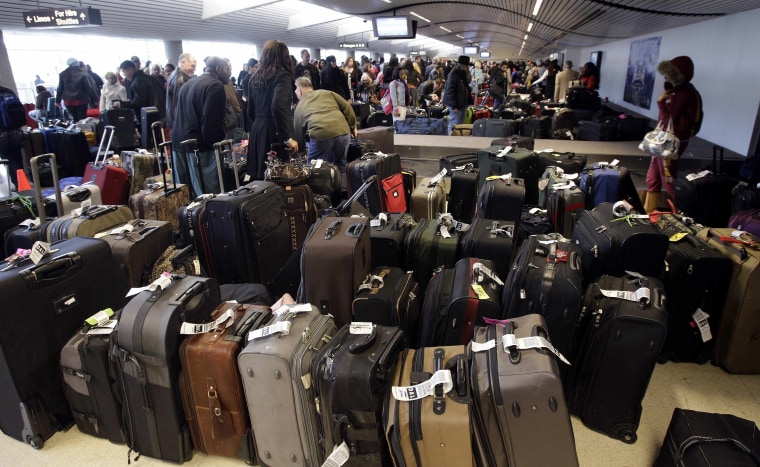Modern day airline passengers juggle a lot of numbers. In addition to remembering flight numbers, gate numbers, seat numbers and figuring out how many liquid ounces fit into a zippered baggie, fliers must pay attention to the fees for checked baggage and calculate the odds of that luggage arriving safely and on time.
The good news is that those odds have been improving. According to statistics recently released by the Department of Transportation (DOT), in 2009, major U.S. carriers reduced the rate of mishandled, mangled and lost bags to the lowest level recorded since 2004.
Hooray, right? Don’t fall off your chair just yet. Last year, major airlines mishandled “just” 3.91 bags per 1,000 passengers. It’s an improvement over 2008's rate of 5.26, but data show more than 2.19 million pieces of luggage went missing in 2009.
What’s behind the numbers?
The mishandled baggage statistics did move in the right direction, so we might conclude that airlines took some of the millions of dollars they’ve been raking in from checked-bag fees and put it toward improving baggage handling systems — some actually did. However, conventional wisdom suggests that improved statistics have more to do with depressed travel patterns than with airline attentiveness.
In 2009, there were fewer passengers, fewer flights and, therefore, fewer checked bags to be mishandled. All those new checked-bag fees, according to SimpliFlying’s Shashank Nigam, caused “many passengers to stop checking-in [any] bags unless absolutely necessary ... and frequent fliers to travel light,” unless they can take advantage of elevated mileage status and check their bags for free. “That’s the secret behind the numbers,” he said.
Will it last?
Don’t get your hopes up. Catherine Mayer, vice president at SITA, a company specializing in information technology for the air transport industry, said mishandled baggage rates will remain lower only until “traffic returns to 2007 levels and we once again put a strain on the infrastructure.”
That is, unless airports, airlines and ground handlers “use this slow travel period to invest in fixing the baggage management system.” Will they? Mayer thinks so, and she has a long list of ideas, ranging from “applications to better track and reconcile baggage during its journey” to making better use of tools that keep travelers more in-touch with the whereabouts or their baggage.
BIP for baggage handlers
One tool being used by airlines, airports and ground handlers is the baggage improvement program (BIP). Created by the International Air Transport Association, the program’s goal is to halve the rate of baggage mishandling by 2012 — globally, not just in the U.S.
While that would certainly make passengers happier, IATA spokesperson Steve Lott said moving toward that goal could also help airlines repair their bottom lines. “Globally, mishandled baggage cost airlines $3.3 billion in 2008, so the airline industry has a financial incentive to make sure they close the gap,” said Lott.
Some BIP fixes may require an investment in costly, sophisticated technology, but some solutions are cheap and simply require applying some common sense. Lott says a few airports and airlines have improved their baggage handling programs by making sure work areas are clean and well-lit. “It’s not rocket science, but if you have bags that are stacked in piles, it is harder to find the bag that you want,” he said. “We’ve also found that it helps to paint spacing lines on the belt behind the check-in counter so bags don’t begin their journey all bunched up.”
Airlines getting with the program
On their own, and often with a little encouragement from the IATA program, airlines are making changes that make a difference. For example, American Airlines has slightly increased the amount of ground time between flights.
“Just a few minutes does two things: it gives us more time to handle baggage and it also gives the crews a little more breathing room to unload and load bags when the aircraft is late arriving on the inbound flight,” airline spokesman Tim Smith said.
Like Alaska, Delta, Southwest and other airlines, American has also adopted technological improvements, such as handheld scanning devices that help track bags through its system. The previous system was paper-based and outdated. Smith said American now has computer terminals installed in many baggage tugs that can provide real-time information for getting connecting bags to the proper flight.
Mission accomplished?
Clearly, we’re not at the point where a passenger checking a bag has no need to wonder if they’ll ever see that bag again. SITA’s Mayer, however, said there’s technology available that, if implemented, would show “real benefits throughout the world and not just at some airports, with some airlines or on certain flight routes.”
Meantime, IATA’s Lott said there are low-tech strategies passengers can adopt to give their checked bags better odds of arriving safely.
For instance, in addition to putting your contact information and travel itinerary inside your baggage, Lott suggests travelers inspect the outside of their bags before each trip. If there are old tag stubs and bar code labels stuck on your luggage from a previous journey, remove them so they don’t confuse the automatic barcode readers in the baggage handling system.
The war to end lost luggage has not yet been won, but airlines are making honest efforts.
Harriet Baskas is a frequent contributor to msnbc.com, authors the “Stuck at the Airport” blog and is a columnist for USATODAY.com. You can follow her on Twitter.
